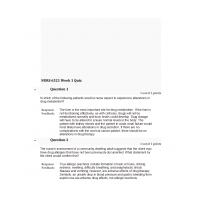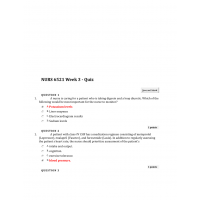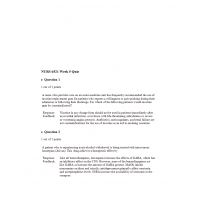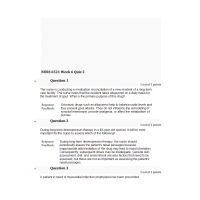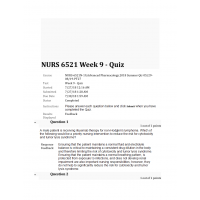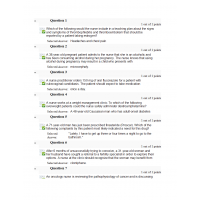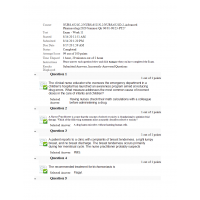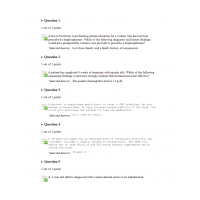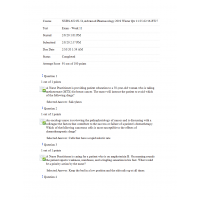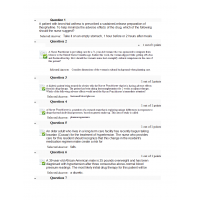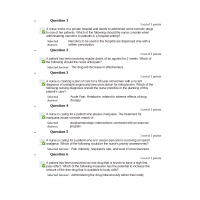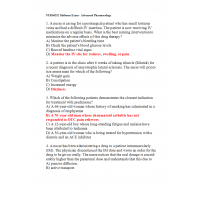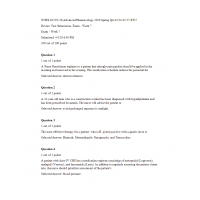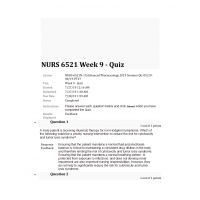NURS 6521N Week 11 Quiz - Question with Answers
1. A nurse is going to administer medication to an infant using a medicine dropper. The best method is to open the child's mouth by gently squeezing the cheeks and placing the drops
2. A patient is being seen in the emergency department for a sprained ankle and is given a drug to relieve pain. When a second dose of the pain medication is given, the patient develops redness of the skin, itching, and swelling at the site of injection of the drug. The most likely cause of this response is
3. A nurse works at a weight management clinic. To which of the following overweight patients could the nurse safely administer dextroamphetamine?
4. A nurse is having difficulty administering a bitter drug to a 5-year-old child. The nurse should
5. A nurse who provides care on a pediatric medicine unit has conducted a medication reconciliation of a recently-admitted patient. In light of the fact that the child takes methylphenidate (Ritalin), the nurse is justified in considering a history of what health problem?
6. A 21-year-old female has a history of irregular menses. She recently became sexually active and would like to begin taking oral contraceptives (OCs). The nurse practitioner recognizes that most likely this patient would benefit from taking which category of OCs.
7. A school nurse has been teaching high school students about the risks associated with marijuana use. However, the nurse has been met with considerable skepticism on the part of students, most of whom believe that marijuana is a benign drug. Which of the following teaching points should the nurse provide?
8. A 12-year-old boy is being discharged from the hospital after major surgery. The boy will be taking two medications at home for an extended period. The nurse who is discharging the patient should provide medication teaching specifically to
9. A 22-year-old woman has given birth to an infant who exhibits the signs and symptoms of maternal cocaine use during pregnancy. These signs and symptoms are a result of what pathophysiological effect of opioid use during pregnancy?
10. A nurse practitioner orders a single dose of 2 g Metronidazole orally. How many milligrams will the patient receive in one dose?
11. A nurse is administering drugs to a 10-year-old child who has multiple health problems. The child is underweight and is on a special diet. Which of the following will the nurse consider when planning for the best absorption of the prescribed drugs? (Select all that apply.)
12. The clinical nurse educator who oversees the emergency department in a children's hospital has launched an awareness program aimed at reducing drug errors. What measure addresses the most common cause of incorrect doses in the care of infants and children?
13. A 3-year-old boy has developed otitis media and requires antibiotics. In order to increase the chance that the boy will take his prescribed medication, the nurse should
14. A 5-year-old boy needs an IM injection. The least painful and most effective injection site would be the
15. A 30-year-old man with a BMI of 59 has recently been diagnosed with type 2 diabetes mellitus. In light of the man's lack of success with weight loss programs in the past, his care provider has prescribed sibutramine (Meridia). What instructions should the nurse consequently provide to this patient?
16. A patient reports to a clinic with complaints of breast tenderness, a right lumpy breast, and no breast discharge. The breast tenderness occurs primarily during her menstrual cycle. The nurse practitioner probably suspects
17. A 6-month-old child has developed skin irritation due to an allergic reaction. He has been prescribed a topical skin ointment. The nurse will consider which of the following before administering the drug?
18. A 16-year-old boy is prescribed cromolyn sodium nasal spray to treat a nasal allergy. To maximize the therapeutic effects of the drug, which of the following will the nurse include in instructions to the patient?
19. The recommended treatment for trichomoniasis is
20. A 15-year-old boy who has been taking dextroamphetamine for the treatment of ADHD has been experiencing a depressed mood and a sense of hopelessness. He confides in the school nurse that he has begun taking his stepfather's antidepressant to improve his mood. After immediately phoning the boy's stepfather, the nurse learns that the drug in question is phenelzine (Nardil), a monoamine oxidase inhibitor (MAOI). The nurse should recognize that this combination of drugs creates a serious risk of what health problem?
21. A 13-year-old female took a weight loss drug that activated the sympathetic nervous system. Which of the following assessment findings would the nurse expect?
22. A nurse working in a cancer center is preparing to administer medication to a 5-year-old child. The nurse will calculate the drug dosage by using
23. A nurse is caring for a 10-year-old boy who complains of chronic headaches. His mother reports that she gives him Tylenol at least three times a day. Which of the following will the nurse work with the physician to evaluate?
24. A 2-year-old child is diagnosed with a minor ailment and is to be administered medications at home for 2 weeks. The child lives with his mother, grandmother, and four other children between the ages of 14 months and 7 years. The home health nurse is asked to assess the home environment to determine if it is appropriate for the child to take his medication at home. Which of the following will have the greatest impact on the nurse's assessment?
25. A 35-year-old woman is on a weight-loss program and is to begin taking sibutramine (Meridia). After baseline physical data are obtained, the nurse will assess the patient's childbearing potential. The nurse will inform the patient that during sibutramine therapy she should
26. A 15-year-old boy has been diagnosed with bone cancer after several months of fatigue and pain. What question should the nurse include in an assessment when trying to minimize the potential for adverse drug reactions?
27. A 10-year-old boy is taking dextroamphetamine (Dexedrine) daily for ADHD. At each clinic visit, the nurse's priority assessment would be
28. An immunocompromised 7-year-old child was recently discharged home with a peripherally-inserted central line (PIC line) for home antibiotic therapy. He has now been brought to the emergency department by his mother and father with signs and symptoms of line sepsis. Upon questioning, the mother states that she has been removing the PIC dressing daily and washing the site with warm water and a cloth. What nursing diagnosis is most appropriate in this situation?
29. A nurse is obtaining baseline physical data from a 7-year-old patient who is to be started on dextroamphetamine for ADHD. After obtaining vital signs, height, and weight, the nurse will prepare the patient for an
30. A nurse is providing patient education to a 13-year-old girl who was just diagnosed with type 1 diabetes mellitus. Which of the following statements by the patient will alert the nurse that special instructions regarding insulin are necessary?
31. A nurse who provides care on a pediatric unit of a hospital is aware that the potential for harm as a result of drug errors is higher among infants and children than adults. This fact is primarily due to
32. A 29-year-old woman who is morbidly obese has recently begun a comprehensive, medically-supervised program of weight reduction. Prior to adding dextroamphetamine (Dexedrine) to her regimen, the patient should be questioned about her intake of
33. A preterm neonate received caffeine for the treatment of apnea. The nurse should monitor the neonate for which of the following?
34. A 19-year-old patient reports to a clinic with vaginal discharge with a foul odor. A microscopic exam reveals trichomonas vaginalis. The nurse practitioner is aware that
35. A child is admitted to the burn unit with second and third degree burns on both arms and part of his or her face. When administering topical medications to the burned areas, the nurse should
36. A patient asks the nurse practitioner about food sources such as soybeans and soy products. The nurse practitioner understands that these foods are considered
37. To which of the following patients would a medication nurse most likely administer caffeine as part of the treatment plan?
38. A nurse practitioner orders 150 mg of oral fluconazole for a patient with vulvovaginal candidiasis. The patient should expect to take medication
39. A nurse is explaining to the parents of a 6-year-old child suffering from angina why nitroglycerin patches for chest pain would not be appropriate. Which of the following will the nurse include in an explanation?
40. A 7-year-old child has been taking tetracycline for a bacterial infection. The nurse will be sure to inform the parents that this drug could cause
NURS 6521 Week 11 Quiz Offlabel medications Nursing NP
1. A nurse practitioner orders 150 mg of oral fluconazole for a patient with vulvovaginal candidiasis. The patient should expect to take medication
2. A nurse is providing patient education to a 13-year-old girl who was just diagnosed with type 1 diabetes mellitus. Which of the following statements by the patient will alert the nurse that special instructions regarding insulin are necessary?
3. A 15-year-old boy who has been taking dextroamphetamine for the treatment of ADHD has been experiencing a depressed mood and a sense of hopelessness. He confides in the school nurse that he has begun taking his stepfather's antidepressant to improve his m
4. A 13-year-old female took a weight loss drug that activated the sympathetic nervous system. Which of the following assessment findings would the nurse expect?
5. A nurse is obtaining baseline physical data from a 7-year-old patient who is to be started on dextroamphetamine for ADHD. After obtaining vital signs, height, and weight, the nurse will prepare the patient for an
6. A 10-year-old boy is taking dextroamphetamine (Dexedrine) daily for ADHD. At each clinic visit, the nurse's priority assessment would be
7. A nurse is having difficulty administering a bitter drug to a 5-year-old child. The nurse should
8. The clinical nurse educator who oversees the emergency department in a children's hospital has launched an awareness program aimed at reducing drug errors. What measure addresses the most common cause of incorrect doses in the care of infants and children
9. A 6-month-old child has developed skin irritation due to an allergic reaction. He has been prescribed a topical skin ointment. The nurse will consider which of the following before administering the drug?
10. A nurse works at a weight management clinic. To which of the following overweight patients could the nurse safely administer dextroamphetamine?
11. A 19-year-old patient reports to a clinic with vaginal discharge with a foul odor. A microscopic exam reveals trichomonas vaginalis. The nurse practitioner is aware that
12. A 30-year-old man with a BMI of 59 has recently been diagnosed with type 2 diabetes mellitus. In light of the man's lack of success with weight loss programs in the past, his care provider has prescribed sibutramine (Meridia). What instructions should the
13. An immunocompromised 7-year-old child was recently discharged home with a peripherally-inserted central line (PIC line) for home antibiotic therapy. He has now been brought to the emergency department by his mother and father with signs and symptoms of li
14. A child is admitted to the burn unit with second and third degree burns on both arms and part of his or her face. When administering topical medications to the burned areas, the nurse should
15. A 7-year-old child has been taking tetracycline for a bacterial infection. The nurse will be sure to inform the parents that this drug could cause
16. A 15-year-old boy has been diagnosed with bone cancer after several months of fatigue and pain. What question should the nurse include in an assessment when trying to minimize the potential for adverse drug reactions?
17. A nurse is administering drugs to a 10-year-old child who has multiple health problems. The child is underweight and is on a special diet. Which of the following will the nurse consider when planning for the best absorption of the prescribed drugs? (Selec
18. A 29-year-old woman who is morbidly obese has recently begun a comprehensive, medically-supervised program of weight reduction. Prior to adding dextroamphetamine (Dexedrine) to her regimen, the patient should be questioned about her intake of
19. A school nurse has been teaching high school students about the risks associated with marijuana use. However, the nurse has been met with considerable skepticism on the part of students, most of whom believe that marijuana is a benign drug. Which of the f
20. A 16-year-old boy is prescribed cromolyn sodium nasal spray to treat a nasal allergy. To maximize the therapeutic effects of the drug, which of the following will the nurse include in instructions to the patient?
21. The recommended treatment for trichomoniasis is
22. A nurse working in a cancer center is preparing to administer medication to a 5-year-old child. The nurse will calculate the drug dosage by using
23. A nurse is caring for a 10-year-old boy who complains of chronic headaches. His mother reports that she gives him Tylenol at least three times a day. Which of the following will the nurse work with the physician to evaluate?
24. A patient asks the nurse practitioner about food sources such as soybeans and soy products. The nurse practitioner understands that these foods are considered
25. A 5-year-old boy needs an IM injection. The least painful and most effective injection site would be the
26. A preterm neonate received caffeine for the treatment of apnea. The nurse should monitor the neonate for which of the following?
27. A patient reports to a clinic with complaints of breast tenderness, a right lumpy breast, and no breast discharge. The breast tenderness occurs primarily during her menstrual cycle. The nurse practitioner probably suspects
28. A 2-year-old child is diagnosed with a minor ailment and is to be administered medications at home for 2 weeks. The child lives with his mother, grandmother, and four other children between the ages of 14 months and 7 years. The home health nurse is asked
29. A nurse who provides care on a pediatric unit of a hospital is aware that the potential for harm as a result of drug errors is higher among infants and children than adults. This fact is primarily due to
30. To which of the following patients would a medication nurse most likely administer caffeine as part of the treatment plan?
31. A nurse practitioner orders a single dose of 2 g Metronidazole orally. How many milligrams will the patient receive in one dose?
32. A 22-year-old woman has given birth to an infant who exhibits the signs and symptoms of maternal cocaine use during pregnancy. These signs and symptoms are a result of what pathophysiological effect of opioid use during pregnancy?
33. 12-year-old boy is being discharged from the hospital after major surgery. The boy will be taking two medications at home for an extended period. The nurse who is discharging the patient should provide medication teaching specifically to
34. A 3-year-old boy has developed otitis media and requires antibiotics. In order to increase the chance that the boy will take his prescribed medication, the nurse should
35. A 35-year-old woman is on a weight-loss program and is to begin taking sibutramine (Meridia). After baseline physical data are obtained, the nurse will assess the patient's childbearing potential. The nurse will inform the patient that during sibutramine
36. A nurse is explaining to the parents of a 6-year-old child suffering from angina why nitroglycerin patches for chest pain would not be appropriate. Which of the following will the nurse include in an explanation?
37. A 21-year-old female has a history of irregular menses. She recently became sexually active, and would like to begin taking oral contraceptives (OCs). The nurse practitioner recognizes that most likely this patient would benefit from taking which category
38. A nurse who provides care on a pediatric medicine unit has conducted a medication reconciliation of a recently-admitted patient. In light of the fact that the child takes methylphenidate (Ritalin), the nurse is justified in considering a history of what h
39. A nurse is going to administer medication to an infant using a medicine dropper. The best method is to open the child's mouth by gently squeezing the cheeks and placing the drops
40. A patient is being seen in the emergency department for a sprained ankle and is given a drug to relieve pain. When a second dose of the pain medication is given, the patient develops redness of the skin, itching, and swelling at the site of injection of t
41. A 35-year-old woman is on a weight-loss program and is to begin taking sibutramine (Meridia). After baseline physical data are obtained, the nurse will assess the patient's childbearing potential. The nurse will inform the patient that during sibutramine
42. To which of the following patients would a medication nurse most likely administer caffeine as part of the treatment plan
43. The clinical nurse educator who oversees the emergency department in a children's hospital has launched an awareness program aimed at reducing drug errors. What measure addresses the most common cause of incorrect doses in the care of infants and children
44. A 7-year-old child has been taking tetracycline for a bacterial infection. The nurse will be sure to inform the parents that this drug could cause
45. A 6-month-old child has developed skin irritation due to an allergic reaction. He has been prescribed a topical skin ointment. The nurse will consider which of the following before administering the drug?
46. A patient asks the nurse practitioner about food sources such as soybeans and soy products. The nurse practitioner understands that these foods are considered
47. A 22-year-old woman has given birth to an infant who exhibits the signs and symptoms of maternal cocaine use during pregnancy. These signs and symptoms are a result of what pathophysiological effect of opioid use during pregnancy
48. A 10-year-old boy is taking dextroamphetamine (Dexedrine) daily for ADHD. At each clinic visit, the nurse's priority assessment would be
49. A nurse works at a weight management clinic. To which of the following overweight patients could the nurse safely administer dextroamphetamine?
50. A 16-year-old boy is prescribed cromolyn sodium nasal spray to treat a nasal allergy. To maximize the therapeutic effects of the drug, which of the following will the nurse include in instructions to the patient?
51. A 13-year-old female took a weight loss drug that activated the sympathetic nervous system. Which of the following assessment findings would the nurse expect?
52. A nurse practitioner orders 150 mg of oral fluconazole for a patient with vulvovaginal candidiasis. The patient should expect to take medication
53. A nurse who provides care on a pediatric unit of a hospital is aware that the potential for harm as a result of drug errors is higher among infants and children than adults. This fact is primarily due to
54. A 30-year-old man with a BMI of 59 has recently been diagnosed with type 2 diabetes mellitus. In light of the man's lack of success with weight loss programs in the past, his care provider has prescribed sibutramine (Meridia). What instructions should the
55. A nurse is caring for a 10-year-old boy who complains of chronic headaches. His mother reports that she gives him Tylenol at least three times a day. Which of the following will the nurse work with the physician to evaluate?
56. A patient reports to a clinic with complaints of breast tenderness, a right lumpy breast, and no breast discharge. The breast tenderness occurs primarily during her menstrual cycle. The nurse practitioner probably suspects
57. A nurse is administering drugs to a 10-year-old child who has multiple health problems. The child is underweight and is on a special diet. Which of the following will the nurse consider when planning for the best absorption of the prescribed drugs? (Selec
58. A 10-year-old boy is taking dextroamphetamine (Dexedrine) daily for ADHD. At each clinic visit, the nurse's priority assessment would be
59. A 15-year-old boy who has been taking dextroamphetamine for the treatment of ADHD has been experiencing a depressed mood and a sense of hopelessness. He confides in the school nurse that he has begun taking his stepfather's antidepressant to improve his m
60. A patient asks the nurse practitioner about food sources such as soybeans and soy products. The nurse practitioner understands that these foods are considered
| Institution & Term/Date | |
| Term/Date | Walden University |
NURS 6521N Week 11 Quiz 2 - 02 Sets (Question and Answers)
- Product Code: 2019
- Availability: In Stock
-
$16.00
Related Products
NURS 6521N Week 10 Quiz
$12.00
NURS 6521N Week 9 Quiz 1
$12.00
Tags: NURS 6521N


